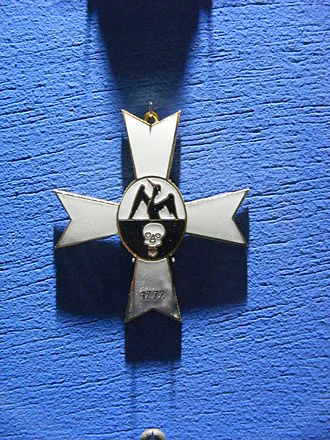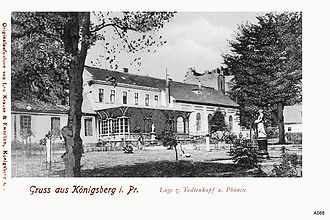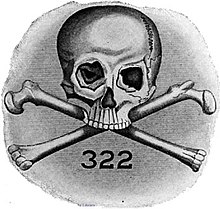To the Todtenkopf and Phoenix
"Zum Todtenkopf und Phoenix" is a Masonic Lodge founded on March 21, 1772 under the name "Zum Todtenkopf" in Königsberg .
history
Lodge establishment
The Johannisloge "Zum Todtenkopf und Phoenix" was founded on March 21, 1772 under the name "Zum Todtenkopfe" in Königsberg by the Freemasons Friedrich Ernst Jester , Christian Jacob Hewelke, Jacob Friedrich Grimm, Nathanael Holst and Johann Ignaz Wierzbicki.
Friedrich Ernst Jester, 29 years old when the lodge was founded, had become a Freemason in Paris in 1764 and later, like Jacob Friedrich Grimm, a member of the "Hope" lodge in Vienna. Nathanael Holst belonged to the “Zum Güldenen Apfel” lodge in Eutin, Johann Ignaz Wierzbicki to the “To the Three Stars” lodge in Gdansk and Christian Jacob Hewelke to the “To the Three Roses” lodge in Hamburg.
The five founding members carried out their first improvised temple work on March 21, 1772, without any official ritual acts or ritual objects. On the day it was founded, the lodge offices were filled by secret ballot and the first “seekers” were accepted into the lodge. Friedrich Ernst Jester was elected chairman of the lodge master. Afterwards, the establishment of the “Todtenkopf Lodge” was celebrated in the Pottmannschen Weinstube with a few glasses of bear catch .
Situation in Königsberg in 1772
The environment in Königsberg was favorable for the newly founded "Todtenkopf-Lodge", the city prospered economically and culturally: After the rigid government of Friedrich Wilhelm I , who had taxed his income high to cover his military expenses, Friedrich II was now . (the great) - who was a Freemason himself - in power since 1740 and ran the business of government in the style of the Age of Enlightenment .
Königsberg had a large seaport with extensive trade connections for the export of wood, grain and amber . Cultural life was shaped by numerous artists' and literary associations and public concerts . From 1770 Kant taught at the Königsberg University, the Albertina founded in 1544 .
The first Königsberg lodge "To the three anchors" was founded as early as 1746. After its dissolution in 1758, the remaining members founded the Lodge Zu den 3 Kronen in 1760 .
The first year of the lodge
Immediately after the establishment of the "Todtenkopf-Lodge", the chairman lodge master Jester sought its recognition through the great state lodge of the Freemasons of Germany, founded by Johann Wilhelm Kellner von Zinnendorf in Berlin in 1770 . In June 1772 Jester von Zinnendorf received the necessary interim constitution as well as the corresponding ritual acts of the St. John's degrees - the lodge was thus recognized as a subsidiary of the grand state lodge.
A formal deed of foundation was not issued until much later and is dated May 3, 1775.
In April 1772 the lodge moved into a house on Tragheimer Pulverstrasse, where on April 21, 1772 the first lodge work was held. The further growth of the lodge led to the fact that this rented accommodation was no longer sufficient and so on November 10, 1772, larger rooms in the house of the red tanner Abel, Auf dem Sackheim, were moved into.
By the end of 1772 the number of members of the “Todtenkopf Lodge” had risen to 34, including eleven officers, ten merchants, five civil servants, two pharmacists, a manor owner, an actor, a medical student and three so-called “serving brothers”.
Revolt against Strict Observance
The Königsberg lodge "To the 3 Kronen" belonged as a subsidiary of the Great National Mother Lodge "To the Three Worlds" to the teaching system of Strict Observance , which was based very heavily on elements of the Templar order and a clerical order. At the time, this teaching system was increasingly rejected by liberal and enlightened Freemasons and ultimately led to the division of the entire Freemasonry in Germany.
The Grand State Lodge founded by Zinnedorf , on the other hand, was based on the Swedish teaching system , a Christian-oriented type of teaching established by Karl Friedrich Eckleff in Sweden.
Like the chairman of the "Todtenkopf-Lodge" Jester, who was known to him, Zinnendorf sought a counterbalance to the strict observance, which was later to be abandoned on October 1, 1779, with the introduction of the Swedish teaching system.
The "Todtenkopf-Lodge" and the older Lodge "Zu den 3 Kronen" had a problematic relationship due to the controversies at the time with regard to the types of teaching, which was at times characterized by mutual distrust and resentment; there were disputes and denunciations. Only after the formal incorporation of the “Todtenkopf Lodge” under the obedience of the Grand State Lodge on May 3, 1775 and the associated formal regulations between the Grand Lodges, there was a mutually accepted regulation of mutual visits.
The establishment of the "Zum Phoenix" lodge
By 1775, the number of members of the “Todtenkopf Lodge” had increased further. The lodge then moved into its own lodge house on Schlossteich (Hinter Tragheim 26/27), right next to the house of the lodge Zu den 3 Kronen (Hinter Tragheim 31). The first temple work took place there on May 25, 1775.
A speech given by Johann Ernst Schultz on the subject of “Wisdom, Strength, Beauty” in March 1775 on the occasion of the 3rd Foundation Festival of the Lodge expressed the spirit of optimism in the Lodge:
"All excellent works are based on a clever system, on a hearty execution and on a tasteful decoration" .
Schultz compared the interaction of wisdom, strength and beauty in doing with
"Raindrops that produce the source by heaping confluence that forms the creek by its abundance swells the stream bed itself and shore digs and by its own power extended" .
In the further course of the year 1775 the number of members of the lodge had grown so strongly that on September 10, 1775 a sister lodge was founded. This was named "Zum Phoenix" and was recognized by a license from the Grand State Lodge on January 30, 1776.
The "Zum Phoenix" lodge had its domicile in the same building on the Schlossteich as the "Todtenkopf-Lodge" and continued to grow in the following years.
Important members of the two lodges in the late 18th and early 19th centuries were the Prussian Lieutenant General Heinrich Christoph Karl Hermann von Wylich and Lottum , the judge and later State Chancellor of the Kingdom of Prussia Carl von Wegnern , the geographer Adam Christian Gaspari and the composer and conductor Friedrich Adam Hiller .
The United St. John's Lodge "Zum Todtenkopf and Phoenix"
The situation changed as a result of the Napoleonic Wars at the end of the 18th and the beginning of the 19th century: many members of the lodges did military service, many never returned; others gave up their businesses because of the economic decline and left Königsberg. The lodges " Zum Todtenkopfe " and " Zum Phoenix " dwindled, so it was decided to unite both lodges.
Thus, on September 10, 1832, the United St. John's Lodge for Todtenkopf and Phoenix was created . In 1899 the lodge had 354 members.
Important members of the lodge in the 19th century were Otto Hieber , the Prussian politician Bruno Abegg , the physicians Karl Heinrich Burow and Ernst von Leyden , the Prussian major general Theodor von Dechen , the theologian and publicist Julius Rupp , and the orientalists Peter von Bohlen and Ferdinand Nesselmann , the agricultural scientist Hermann Settegast and the bacteriologist Julius Richard Petri .
Important members of the lodge in the early 20th century were the musicologist and composer Łucjan Kamieński , the conductor Werner Ladwig , the chemist Samuel Goy and the politician and journalist Eduard Kenkel .
Otto Hieber
In 1869, at the age of 29, Otto Hieber was admitted to the “Zum Todtenkopf und Phoenix” lodge. Hieber was elected chairman of the lodge master in 1885 and held this office for an exceptionally long period of 37 years until 1922.
As chairman of the lodge master for many years, he not only shaped the lodge “Zum Todtenkopf und Phoenix”, but also, as its senior, the teaching of the great state lodge of the Freemasons of Germany through numerous exegetical writings that are still valid today.
A medal in honor of Otto Hieber is exhibited in the Kant Museum in Königsberg Cathedral , in today's Kaliningrad , where other objects from the lodge from before 1933 are also on display.
A bust of Otto Hieber stands in the order house of the great state box of the Freemasons of Germany in Berlin-Dahlem.
The "Masonic Window" in Königsberg Cathedral
Between 1901 and 1906 the glass painters Rudolf and Otto Linnemann from Frankfurt / M created. a total of eleven church windows for the Königsberg Cathedral . The window for the baptistery of the cathedral was donated by the Königsberg lodges "Zum Todtenkopf und Phoenix", "Zu den Drei Kronen" and "Immanuel".
In addition to the baptism of Jesus by John the Baptist , the window also showed some Masonic symbols as well as the emblems of the three founding lodges in the lower area of the window. Documents and photos for the window are in the Linnemann archive in Frankfurt / M.
The window was lost due to the extensive destruction of the cathedral in the Second World War. In the course of the restoration of the baptistery by the Russian builder Igor Alexandrowitsch Odinzow , this window was also made from the original, which was found in an archive in Olsztyn, Poland , and has been on display in the cathedral since 2008.
Time of National Socialism and the prohibition of Freemasonry in Germany
With the beginning of the Nazi dictatorship from 1933 and their efforts to ban Freemasonry, the lodge's work became increasingly difficult.
The last Masonic work of the lodge "Zum Todtenkopf und Phoenix" took place at the end of 1933. On January 14, 1934, the police and the SS searched the lodge house in Hinter Tragheim; All ritual objects and documents were confiscated and the chairman of the lodge, Perrey, was temporarily detained.
The lodge was officially banned and dissolved by an official order in June 1935, and all its assets and property were confiscated.
New beginning in Berlin after 1945
It was not until 1947 that the first lodges in West Germany and West Berlin were reactivated, including the "Zum Todtenkopf und Phoenix" lodge. Together with other lodges, the lodge first moved into the partially destroyed lodge house of the Great State Lodge on Eisenacher Strasse. Despite the material difficulties of the post-war period, new members were accepted over time and the lodge began to gain strength again.
Since 1965 the "Zum Todtenkopf und Phoenix" lodge has been located in what is today the order house of the Great State Lodge of the Freemasons of Germany in Berlin-Dahlem . With Georg C. Frommholz, the lodge provided the state grandmaster of the great state lodge of the Freemasons of Germany from 1973 to 1981 .
The lodge is one of the largest and best-known lodges in Germany that work according to the Swedish way of teaching .
Presiding lodge master from 1772 to 1967
FE Jester
(1772-1818)O. Hieber
(1885-1922)R. Armstedt
(1923)
Trivia
In their book Secret Societies: Freemasons and Illuminati, Opus Dei and Black Hand , which appeared in 2013 as an accompanying book to a ZDF documentary series on secret societies, the authors Gisela Graichen and Alexander Hesse deal with the American student association Skull & Bones in addition to the Freemasons . They respond to assumptions according to which Skull & Bones founder William Huntington Russell is said to have borrowed numerous ritual and symbolic elements from the association he founded in 1832 from student or Masonic organizations in Germany, as he was responsible for immediately before founding Skull & Bones had stayed in Germany for several months. The authors put forward the hypothesis that Russell could have been in Koenigsberg during his stay in Germany and might have then borrowed his skull & bones symbolism from the emblem of the Masonic lodge Zum Todtenkopf and Phoenix there .
The Austrian author David GL Weiss processes this hypothesis in his 2013 novel "Macht", a conspiracy thriller in which Skull & Bones plays a major role. In her research on the possible (fictitious) connections between Skull & Bones and Prussia , the main character of the novel also speculates about a possible connection between Skull & Bones and the Lodge Zum Todtenkopf and Phoenix .
The author and ufologist Andreas von Rétyi outlines an even more extensive conspiracy theory in his book Power and Secret of the Illuminati , published in 2004 : According to this, Skull & Bones is the continuation of the Order of Illuminati . The number 322 refers in the calendar of Skull & Bones to the year 1832. In this year Skull & Bones was founded, and at the same time the merging of the lodges Zum Todtenkopf and Zum Phoenix to form the United St. John's Lodge Zum Todtenkopf and Phoenix . This amalgamation, at the same time as the founding of Skull & Bones, symbolizes the fall of the old Illuminati order in Germany (Todtenkopf) and its resurrection in the USA in the form of Skull & Bones (Phoenix).
literature
- Otto Hieber : History of the United Johannis Lodge to Todtenkopf and Phoenix zu Königsberg i. Pr. Königsberg 1897, self-published by the author
- Richard Armstedt : History of the United Johannis Lodge to the Totenkopf and Phoenix zu Königsberg i. Pr. In the years 1897–1922. Koenigsberg 1922.
- Eugen Lennhoff, Oskar Posner, Dieter A. Binder: Internationales Freemaurerlexikon. Revised and expanded new edition of the 1932 edition, Munich 2003, ISBN 3-7766-2161-3 .
- Ferdinand Runkel: History of Freemasonry. Edition Lempertz, Bonn 2006, ISBN 3-933070-96-1 .
- Klaus CF Feddersen: Constitutions, statutes and rules of the order of the Freemasons in England, France, Germany and Scandinavia. A historical source study from the constitutions of the Masonic systems, in particular on the religious and Christian tradition in Freemasonry. Published by the Freemason Research Association Frederik the Great State Lodge of the Freemasons of Germany.
- Chronicle of the St. John's Lodge "Zum Todtenkopfe und Phoenix". Berlin 2009, self-published by the “Zum Todtenkopf und Phoenix” lodge.
- Lorenz Grimoni : Freemason in Koenigsberg (Pr) , published in: Koenigsberger Bürgerbrief, Issue No. 69 , Museum Stadt Koenigsberg, Duisburg, 2007
- Karlheinz Gerlach: The Freemasons in Old Prussia 1738–1806 ; in: Helmut Reinalter (ed.): Sources and representations on European Freemasonry , Studienverlag, Innsbruck, 2009, ISBN 978-3-7065-4383-5
Web links
Individual evidence
- ↑ a b c d e f General Manual of Freemasonry. Third edition of Lenning's Encyclopedia of Freemasonry , completely revised and brought in line with new scientific research . Association of German Freemasons, Max Hesse's Verlag, Leipzig 1900.
- ↑ Archived copy ( Memento of the original from July 28, 2016 in the Internet Archive ) Info: The archive link was inserted automatically and has not yet been checked. Please check the original and archive link according to the instructions and then remove this notice. , accessed April 12, 2015
- ↑ Lorenz Grimoni : Freemasons in Königsberg (Pr) , published in: Königsberger Bürgerbrief, Issue No. 69 , Museum Stadt Königsberg, Duisburg, 2007
- ↑ Manual of GLLFvD 2007
- ↑ Tom Goeller: Freemasons - Enlightenment of a Myth , be.bra Verlag, Berlin 2006, p. 158
- ↑ Gisela Graichen with Alexander Hesse: Secret societies. Freemasons and Illuminati, Opus Dei and Black Hand. Rowohlt, 2013, ISBN 978-3-498-02526-7
- ^ David GL Weiss: Macht , Verlag Langen Müller, Munich 2013, ISBN 978-3-7844-3336-3
- ^ Andreas von Rétyi: Power and Secret of the Illuminati , Kopp-Verlag, Rottenburg am Neckar, 2004, ISBN 978-3-930219-94-0 , p. 164 ff.



























